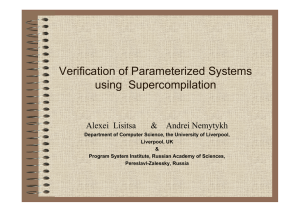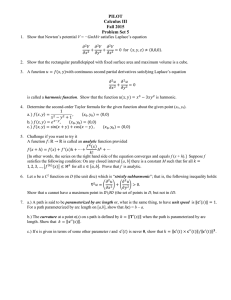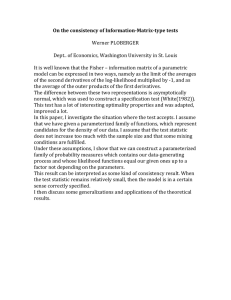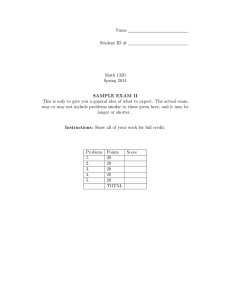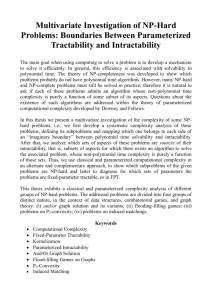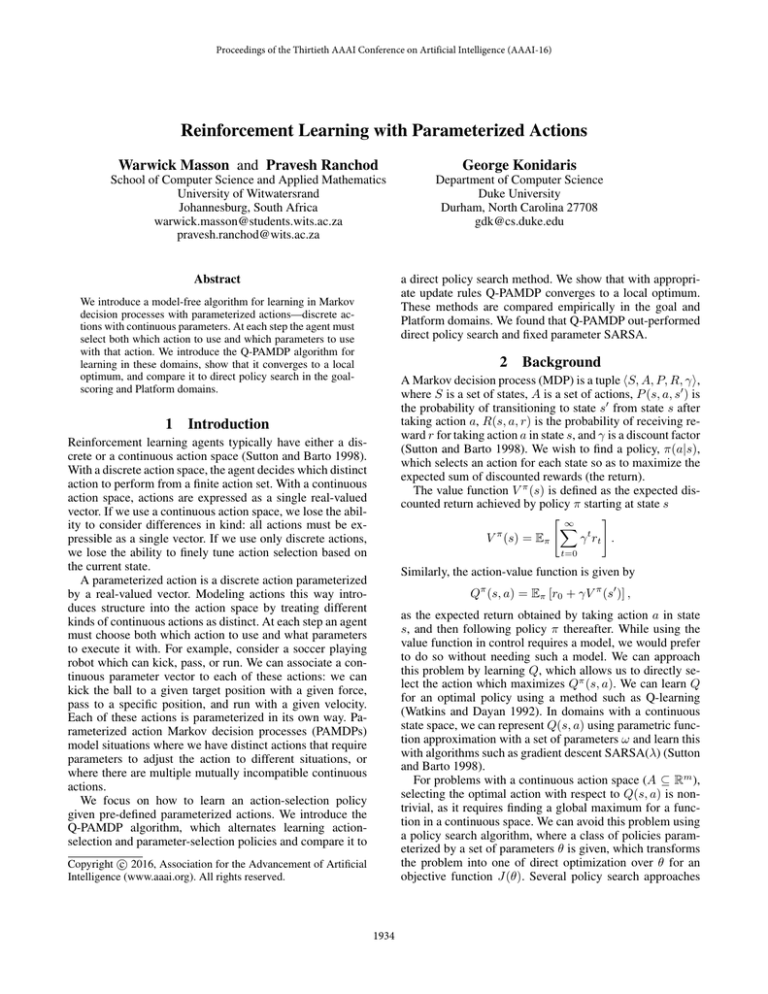
Proceedings of the Thirtieth AAAI Conference on Artificial Intelligence (AAAI-16)
Reinforcement Learning with Parameterized Actions
Warwick Masson and Pravesh Ranchod
George Konidaris
School of Computer Science and Applied Mathematics
University of Witwatersrand
Johannesburg, South Africa
warwick.masson@students.wits.ac.za
pravesh.ranchod@wits.ac.za
Department of Computer Science
Duke University
Durham, North Carolina 27708
gdk@cs.duke.edu
a direct policy search method. We show that with appropriate update rules Q-PAMDP converges to a local optimum.
These methods are compared empirically in the goal and
Platform domains. We found that Q-PAMDP out-performed
direct policy search and fixed parameter SARSA.
Abstract
We introduce a model-free algorithm for learning in Markov
decision processes with parameterized actions—discrete actions with continuous parameters. At each step the agent must
select both which action to use and which parameters to use
with that action. We introduce the Q-PAMDP algorithm for
learning in these domains, show that it converges to a local
optimum, and compare it to direct policy search in the goalscoring and Platform domains.
1
2
Background
A Markov decision process (MDP) is a tuple S, A, P, R, γ,
where S is a set of states, A is a set of actions, P (s, a, s ) is
the probability of transitioning to state s from state s after
taking action a, R(s, a, r) is the probability of receiving reward r for taking action a in state s, and γ is a discount factor
(Sutton and Barto 1998). We wish to find a policy, π(a|s),
which selects an action for each state so as to maximize the
expected sum of discounted rewards (the return).
The value function V π (s) is defined as the expected discounted return achieved by policy π starting at state s
∞
γ t rt .
V π (s) = Eπ
Introduction
Reinforcement learning agents typically have either a discrete or a continuous action space (Sutton and Barto 1998).
With a discrete action space, the agent decides which distinct
action to perform from a finite action set. With a continuous
action space, actions are expressed as a single real-valued
vector. If we use a continuous action space, we lose the ability to consider differences in kind: all actions must be expressible as a single vector. If we use only discrete actions,
we lose the ability to finely tune action selection based on
the current state.
A parameterized action is a discrete action parameterized
by a real-valued vector. Modeling actions this way introduces structure into the action space by treating different
kinds of continuous actions as distinct. At each step an agent
must choose both which action to use and what parameters
to execute it with. For example, consider a soccer playing
robot which can kick, pass, or run. We can associate a continuous parameter vector to each of these actions: we can
kick the ball to a given target position with a given force,
pass to a specific position, and run with a given velocity.
Each of these actions is parameterized in its own way. Parameterized action Markov decision processes (PAMDPs)
model situations where we have distinct actions that require
parameters to adjust the action to different situations, or
where there are multiple mutually incompatible continuous
actions.
We focus on how to learn an action-selection policy
given pre-defined parameterized actions. We introduce the
Q-PAMDP algorithm, which alternates learning actionselection and parameter-selection policies and compare it to
t=0
Similarly, the action-value function is given by
Qπ (s, a) = Eπ [r0 + γV π (s )] ,
as the expected return obtained by taking action a in state
s, and then following policy π thereafter. While using the
value function in control requires a model, we would prefer
to do so without needing such a model. We can approach
this problem by learning Q, which allows us to directly select the action which maximizes Qπ (s, a). We can learn Q
for an optimal policy using a method such as Q-learning
(Watkins and Dayan 1992). In domains with a continuous
state space, we can represent Q(s, a) using parametric function approximation with a set of parameters ω and learn this
with algorithms such as gradient descent SARSA(λ) (Sutton
and Barto 1998).
For problems with a continuous action space (A ⊆ Rm ),
selecting the optimal action with respect to Q(s, a) is nontrivial, as it requires finding a global maximum for a function in a continuous space. We can avoid this problem using
a policy search algorithm, where a class of policies parameterized by a set of parameters θ is given, which transforms
the problem into one of direct optimization over θ for an
objective function J(θ). Several policy search approaches
c 2016, Association for the Advancement of Artificial
Copyright Intelligence (www.aaai.org). All rights reserved.
1934
is a tuple (a, x) where a is a discrete action and x are the
parameters for that action. The action space is then given by
{(a, x) | x ∈ Xa },
A=
a∈Ad
(a) The discrete action space
consists of a finite set of distinct
actions.
which is the union of each discrete action with all possible
parameters for that action. We refer to such MDPs as parameterized action MDPs (PAMDPs). Figure 1 depicts the
different action spaces.
We apply a two-tiered approach for action selection: first
selecting the parameterized action, then selecting the parameters for that action. The discrete-action policy is denoted
π d (a|s). To select the parameters for the action, we define
the action-parameter policy for each action a as π a (x|s).
The policy is then given by
(b) The continuous action space
is a single continuous real-valued
space.
π(a, x|s) = π d (a|s)π a (x|s).
In other words, to select a complete action (a, x), we sample
a discrete action a from π d (a|s) and then sample a parameter x from π a (x|s). The action policy is defined by the parameters ω and is denoted by πωd (a|s). The action-parameter
policy for action a is determined by a set of parameters θa ,
and is denoted πθa (x|s). The set of these parameters is given
by θ = [θa1 , . . . , θak ].
The first approach we consider is direct policy search. We
use a direct policy search method to optimize the objective
function.
J(θ, ω) = Es0 ∼D [V πΘ (s0 )].
(c) The parameterized action space has multiple discrete actions, each of which has a continuous parameter space.
Figure 1: Three types of action spaces: discrete, continuous,
and parameterized.
exist, including policy gradient methods, entropy-based approaches, path integral approaches, and sample-based approaches (Deisenroth, Neumann, and Peters 2013).
with respect to (θ, ω), where s0 is a state sampled according
to the state distribution D. J is the expected return for a
given policy starting at an initial state.
Our second approach is to alternate updating the
parameter-policy and learning an action-value function for
the discrete actions. For any PAMDP M = S, A, P, R, γ
with a fixed parameter-policy πθa , there exists a corresponding discrete action MDP, Mθ = S, Ad , Pθ , Rθ , γ, where
πθa (x|s)P (s |s, a, x)dx,
Pθ (s |s, a) =
Parameterized Tasks
A parameterized task is a problem defined by a task parameter vector τ given at the beginning of each episode. These parameters are fixed throughout an episode, and the goal is to
learn a task dependent policy. Kober et al. (2012) developed
algorithms to adjust motor primitives to different task parameters. They apply this to learn table-tennis and darts with
different starting positions and targets. Da Silva et al. (2012)
introduced the idea of a parameterized skill as a task dependent parameterized policy. They sample a set of tasks, learn
their associated parameters, and determine a mapping from
task to policy parameters. Deisenroth et al. (2014) applied
a model-based method to learn a task dependent parameterized policy. This is used to learn task dependent policies
for ball-hitting task, and for solving a block manipulation
problem. Parameterized tasks can be used as parameterized
actions. For example, if we learn a parameterized task for
kicking a ball to position τ , this could be used as a parameterized action kick-to(τ ).
3
x∈Xa
Rθ (r|s, a) =
πθa (x|s)R(r|s, a, x)dx.
x∈Xa
We represent the action-value function for Mθ using function approximation with parameters ω. For Mθ , there exists
an optimal set of representation weights ωθ∗ which maximizes J(θ, ω) with respect to ω. Let
W (θ) = arg max J(θ, ω) = ωθ∗ .
ω
We can learn W (θ) for a fixed θ using a Q-learning algorithm. Finally, we define for fixed ω,
Parameterized Action MDPs
Jω (θ) = J(θ, ω),
H(θ) = J(θ, W (θ)).
We consider MDPs where the state space is continuous (S ⊆
Rn ) and the actions are parameterized: there is a finite set of
discrete actions Ad = {a1 , a2 , . . . , ak }, and each a ∈ Ad
has a set of continuous parameters Xa ⊆ Rma . An action
H(θ) is the performance of the best discrete policy for a
fixed θ.
1935
Algorithm 1 Q-PAMDP(k)
Therefore by equation 1 the sequence θt converges to a local
optimum θ∗ with respect to H. Let ω ∗ = W (θ∗ ). As θ∗ is a
local optimum with respect to H, by definition there exists
> 0, s.t.
||θ∗ − θ||2 < =⇒ H(θ) ≤ H(θ∗ ).
Therefore for any ω,
θ∗
∗ − θ < =⇒ ||θ∗ − θ|| < 2
ω
ω 2
Input:
Initial parameters θ0 , ω0
Parameter update method P-UPDATE
Q-learning algorithm Q-LEARN
Algorithm:
ω ← Q-LEARN(∞) (Mθ , ω0 )
repeat
θ ← P-UPDATE(k) (Jω , θ)
ω ← Q-LEARN(∞) (Mθ , ω)
until θ converges
=⇒ H(θ) ≤ H(θ∗ )
=⇒ J(θ, ω) ≤ J(θ∗ , ω ∗ ).
Therefore (θ∗ , ω ∗ ) is a local optimum with respect to J.
In summary, if we can locally optimize θ, and ω = W (θ)
at each step, then we will find a local optimum for J(θ, ω).
The conditions for the previous theorem can be met by assuming that P-UPDATE is a local optimization method such
as a gradient based policy search. A similar argument shows
that if the sequence θt converges to a global optimum with
respect to H, then Q-PAMDP(1) converges to a global optimum (θ∗ , ω ∗ ).
One problem is that at each step we must re-learn W (θ)
for the updated value of θ. We now show that if updates to θ
are bounded and W (θ) is a continuous function, then the required updates to ω will also be bounded. Intuitively, we are
supposing that a small update to θ results in a small change
in the weights specifying which discrete action to choose.
The assumption that W (θ) is continuous is strong, and may
not be satisfied by all PAMDPs. It is not necessary for the
operation of Q-PAMDP(1), but when it is satisfied we do
not need to completely re-learn ω after each update to θ. We
show that by selecting an appropriate α we can shrink the
differences in ω as desired.
Theorem 4.2 (Bounded Updates to ω). If W is continuous
with respect to θ, and updates to θ are of the form
θt+1 = θt + αt P-UPDATE(θt , ωt ),
with the norm of each P-UPDATE bounded by
0 < ||P-UPDATE(θt , ωt )||2 < δ,
for some δ > 0, then for any difference in ω > 0, there is
an initial update rate α0 > 0 such that
αt < α0 =⇒ ||ωt+1 − ωt ||2 < .
Proof. Let > 0 and
δ
.
α0 =
||P-UPDATE(θt , ωt )||2
As αt < α0 , it follows that
δ > αt ||P-UPDATE(θt , ωt )||2
= ||αt P-UPDATE(θt , ωt )||2
= ||θt+1 − θt ||2 .
So we have
||θt+1 − θt ||2 < δ.
As W is continuous, this means that
||W (θt+1 ) − W (θt )||2 = ||ωt+1 − ωt ||2 < .
Algorithm 1 describes a method for alternating updating
θ and ω. The algorithm uses two input methods: P-UPDATE
and Q-LEARN and a positive integer parameter k, which
determines the number of updates to θ for each iteration.
P-UPDATE(f, θ) should be a policy search method that optimizes θ with respect to objective function f . Q-LEARN
can be any algorithm for Q-learning with function approximation. We consider two main cases of the Q-PAMDP algorithm: Q-PAMDP(1) and Q-PAMDP(∞).
Q-PAMDP(1) performs a single update of θ and then relearns ω to convergence. If at each step we only update θ
once, and then update ω until convergence, we can optimize
θ with respect to H. In the next section we show that if we
can find a local optimum θ with respect to H, then we have
found a local optimum with respect to J.
4
Theoretical Results
We now show that Q-PAMDP(1) converges to a local or
global optimum with mild assumptions. We assume that iterating P-UPDATE converges to some θ∗ with respect to a
given objective function f . As the P-UPDATE step is a design choice, it can be selected with the appropriate convergence property. Q-PAMDP(1) is equivalent to the sequence
ωt+1 = W (θt )
θt+1 = P-UPDATE(Jωt+1 , θt ),
if Q-LEARN converges to W (θ) for each given θ.
Theorem 4.1 (Convergence to a Local Optimum). For any
θ0 , if the sequence
θt+1 = P-UPDATE(H, θt ),
(1)
converges to a local optimum with respect to H, then QPAMDP(1) converges to a local optimum with respect to J.
Proof. By definition of the sequence above ωt = W (θt ), so
it follows that
Jωt = J(θ, W (θ)) = H(θ).
In other words, the objective function J equals H if ω =
W (θ). Therefore, we can replace J with H in our update
for θ, to obtain the update rule
θt+1 = P-UPDATE(H, θt ).
1936
Proof. By definition of W , ωt+1 = arg maxω J(θt+1 , ω).
Therefore this algorithm takes the form of direct alternating optimization. As such, it converges to a local optimum
(Bezdek and Hathaway 2002).
In other words, if our update to θ is bounded and W is
continuous, we can always adjust the learning rate α so that
the difference between ωt and ωt+1 is bounded.
With Q-PAMDP(1) we want P-UPDATE to optimize
H(θ). One logical choice would be to use a gradient update.
The next theorem shows that gradient of H is equal to the
gradient of J if ω = W (θ). This is useful as we can apply
existing gradient-based policy search methods to compute
the gradient of J with respect to θ. The proof follows from
the fact that we are at a global optimum of J with respect to
ω, and so the gradient ∇ω J is zero. This theorem requires
that W is differentiable (and therefore also continuous).
Theorem 4.3 (Gradient of H(θ)). If J(θ, ω) is differentiable
with respect to θ and ω and W (θ) is differentiable with respect to θ, then the gradient of H is given by ∇θ H(θ) =
∇θ J(θ, ω ∗ ), where ω ∗ = W (θ).
Q-PAMDP(∞) has weaker convergence properties than
Q-PAMDP(1), as it requires a globally convergent PUPDATE. However, it has the potential to bypass nearby
local optima (Bezdek and Hathaway 2002).
5
We first consider a simplified robot soccer problem (Kitano
et al. 1997) where a single striker attempts to score a goal
against a keeper. Each episode starts with the player at a
random position along the bottom bound of the field. The
player starts with the ball in possession, and the keeper is
positioned between the ball and the goal. The game takes
place in a 2D environment where the player and the keeper
have a position, velocity and orientation and the ball has a
position and velocity, resulting in 14 continuous state variables.
An episode ends when the keeper possesses the ball, the
player scores a goal, or the ball leaves the field. The reward
for an action is 0 for non-terminal state, 50 for a terminal
goal state, and −d for a terminal non-goal state, where d
is the distance of the ball to the goal. The player has two
parameterized actions: kick-to(x, y), which kicks to ball towards position (x, y); and shoot-goal(h), which shoots the
ball towards a position h along the goal line. Noise is added
to each action. If the player is not in possession of the ball, it
moves towards it. The keeper has a fixed policy: it moves towards the ball, and if the player shoots at the goal, the keeper
moves to intercept the ball.
To score a goal, the player must shoot around the keeper.
This means that at some positions it must shoot left past the
keeper, and at others to the right past the keeper. However at
no point should it shoot at the keeper, so an optimal policy
is discontinuous. We split the action into two parameterized
actions: shoot-goal-left, shoot-goal-right. This allows us to
use a simple action selection policy instead of complex continuous action policy. This policy would be difficulty to represent in a purely continuous action space, but is simpler in
a parameterized action setting.
We represent the action-value function for the discrete action a using linear function approximation with Fourier basis features (Konidaris, Osentoski, and Thomas 2011). As
we have 14 state variables, we must be selective in which
basis functions to use. We only use basis functions with
two non-zero elements and exclude all velocity state variables. We use the soft-max discrete action policy (Sutton
and Barto 1998). We represent the action-parameter policy πθa as a normal distribution around a weighted sum of
features πθa (x|s) = N (θaT ψa (s), Σ), where θa is a matrix of weights, and ψa (s) gives the features for state s,
and Σ is a fixed covariance matrix. We use specialized features for each action. For the shoot-goal actions we are using a simple linear basis (1, g), where g is the projection
of the keeper onto the goal line. For kick-to we use linear features (1, bx, by, bx2 , by 2 , (bx − kx)/ ||b − k||2 , (by −
Proof. If θ ∈ Rn and ω ∈ Rm , then we can compute the
gradient of H by the chain rule:
∂H(θ)
∂J(θ, W (θ))
=
∂θi
∂θi
n
m
∂J(θ, ω ∗ ) ∂θj ∂J(θ, ω ∗ ) ∂ωk∗
=
+
∂θj
∂θi
∂ωk∗
∂θi
j=1
k=1
=
∗
∂J(θ, ω )
+
∂θi
m
∂J(θ, ω ∗ ) ∂ω ∗
∂ωk∗
k=1
k
∂θi
Experiments
,
where ω ∗ = W (θ). Note that as by definitions of W ,
ω ∗ = W (θ) = arg max J(θ, ω),
ω
we have that the gradient of J with respect to ω is zero
∂J(θ, ω ∗ )/∂ωk∗ = 0, as ω is a global maximum with respect
to J for fixed θ. Therefore, we have that
∇θ H(θ) = ∇θ J(θ, ω ∗ ).
To summarize, if W (θ) is continuous and P-UPDATE
converges to a global or local optimum, then Q-PAMDP(1)
will converge to a global or local optimum, respectively, and
the Q-LEARN step will be bounded if the update rate of
the P-UPDATE step is bounded. As such, if P-UPDATE is a
policy gradient update step then Q-PAMDP by Theorem 4.1
will converge to a local optimum and by Theorem 4.4 the
Q-LEARN step will require a fixed number of updates. This
policy gradient step can use the gradient of J with respect to
θ.
With Q-PAMDP(∞) each step performs a full optimization on θ and then a full optimization of ω. The θ step would
optimize J(θ, ω), not H(θ), as we do update ω while we
update θ. Q-PAMDP(∞) has the disadvantage of requiring
global convergence properties for the P-UPDATE method.
Theorem 4.4 (Local Convergence of Q-PAMDP(∞)). If at
each step of Q-PAMDP(∞) for some bounded set Θ:
θt+1 = arg max J(θ, ωt ),
θ∈Θ
ωt+1 = W (θt+1 ),
then Q-PAMDP(∞) converges to a local optimum.
1937
ky)/ ||b − k||2 ), where (bx, by) is the position of the ball
and (kx, ky) is the position of the keeper.
For the direct policy search approach, we use the episodic
natural actor critic (eNAC) algorithm (Peters and Schaal
2008), computing the gradient of J(ω, θ) with respect to
(ω, θ). For the Q-PAMDP approach we use the gradientdescent Sarsa(λ) algorithm for Q-learning, and the eNAC
algorithm for policy search. At each step we perform one
eNAC update based on 50 episodes and then refit Qω using
50 gradient descent Sarsa(λ) episodes.
Figure 3: A robot soccer goal episode using a converged QPAMDP(1) policy. The player runs to one side, then shoots
immediately upon overtaking the keeper.
Figure 4: A screenshot from the Platform domain. The
player hops over an enemy, and then leaps over a gap.
Figure 2: Average goal scoring probability, averaged over
20 runs for Q-PAMDP(1), Q-PAMDP(∞), fixed parameter
Sarsa, and eNAC in the goal domain. Intervals show standard error.
tal length of all the platforms and gaps. The agent has two
primitive actions: run or jump, which continue for a fixed period or until the agent lands again respectively. There are two
different kinds of jumps: a high jump to get over enemies,
and a long jump to get over gaps between platforms. The
domain therefore has three parameterized actions: run(dx),
hop(dx), and leap(dx). The agent only takes actions while
on the ground, and enemies only move when the agent is
on their platform. The state space consists of four variables
(x, ẋ, ex, ex),
˙ representing the agent position, agent speed,
enemy position, and enemy speed respectively. For learning
Qω , as in the previous domain, we use linear function approximation with the Fourier basis. We apply a softmax discrete action policy based on Qω , and a Gaussian parameter
policy based on scaled parameter features ψa (s).
Figure 5 shows the performance of eNAC, Q-PAMDP(1),
Q-PAMDP(∞), and SARSA with fixed parameters. Both
Q-PAMDP(1) and Q-PAMDP(∞) outperformed the fixed
parameter SARSA method, reaching on average 50% and
65% of the total distance respectively. We suggest that QPAMDP(∞) outperforms Q-PAMDP(1) due to the nature
of the Platform domain. Q-PAMDP(1) is best suited to domains with smooth changes in the action-value function with
respect to changes in the parameter-policy. With the Platform domain, our initial policy is unable to make the first
jump without modification. When the policy can reach the
second platform, we need to drastically change the actionvalue function to account for this platform. Therefore, Q-
Return is directly correlated with goal scoring probability,
so their graphs are close to indentical. As it is easier to interpret, we plot goal scoring probability in figure 2. We can
see that direct eNAC is outperformed by Q-PAMDP(1) and
Q-PAMDP(∞). This is likely due to the difficulty of optimizing the action selection parameters directly, rather than
with Q-learning.
For both methods, the goal probability is greatly increased: while the initial policy rarely scores a goal, both
Q-PAMDP(1) and Q-PAMDP(∞) increase the probability
of a goal to roughly 35%. Direct eNAC converged to a local maxima of 15%. Finally, we include the performance
of SARSA(λ) where the action parameters are fixed at
the initial θ0 . This achieves roughly 20% scoring probability. Both Q-PAMDP(1) and Q-PAMDP(∞) strongly outperform fixed parameter SARSA, but eNAC does not. Figure
3 depicts a single episode using a converged Q-PAMDP(1)
policy— the player draws the keeper out and strikes when
the goal is open.
Next we consider the Platform domain, where the agent
starts on a platform and must reach a goal while avoiding
enemies. If the agent reaches the goal platform, touches an
enemy, or falls into a gap between platforms, the episode
ends. This domain is depicted in figure 4. The reward for a
step is the change in x value for that step, divided by the to-
1938
parameterized wait action (Rachelson, Fabiani, and Garcia
2009). This research also takes a planning perspective, and
only considers a time dependent domain. Additionally, the
size of the parameter space for the parameterized actions is
the same for all actions.
Hoey et al. (2013) considered mixed discrete-continuous
actions in their work on Bayesian affect control theory. To
approach this problem they use a form of POMCP, a Monte
Carlo sampling algorithm, using domain specific adjustments to compute the continuous action components (Silver
and Veness 2010). They note that the discrete and continuous components of the action space reflect different control aspects: the discrete control provides the “what”, while
the continuous control describes the “how” (Hoey, Schroder,
and Alhothali 2013).
In their research on symbolic dynamic programming
(SDP) algorithms, Zamani et al. (2012) considered domains
with a set of discrete parameterized actions. Each of these
actions has a different parameter space. Symbolic dynamic
programming is a form of planning for relational or firstorder MDPs, where the MDP has a set of logical relationships defining its dynamics and reward function. Their algorithms represent the value function as an extended algebraic
decision diagram (XADD), and is limited to MDPs with predefined logical relations.
A hierarchical MDP is an MDP where each action has
subtasks. A subtask is itself an MDP with its own states
and actions which may have their own subtasks. Hierarchical MDPs are well-suited for representing parameterized actions as we could consider selecting the parameters for a discrete action as a subtask. MAXQ is a method for value function decomposition of hierarchical MDPs (Dietterich 2000).
One possiblity is to use MAXQ for learning the actionvalues in a parameterized action problem.
Figure 5: Average percentage distance covered, averaged
over 20 runs for Q-PAMDP(1), Q-PAMDP(∞), and eNAC
in the Platform domain. Intervals show standard error.
Figure 6: A successful episode of the Platform domain.
The agent hops over the enemies, leaps over the gaps, and
reaches the last platform.
PAMDP(1) may be poorly suited to this domain as the small
change in parameters that occurs between failing to making
the jump and actually making it results in a large change
in the action-value function. This is better than the fixed
SARSA baseline of 40%, and much better than direct optimization using eNAC which reached 10%. Figure 6 shows
a successfully completed episode of the Platform domain.
6
7
Conclusion
The PAMDP formalism models reinforcement learning domains with parameterized actions. Parameterized actions
give us the adaptibility of continuous domains and to use
distinct kinds of actions. They also allow for simple representation of discontinuous policies without complex parameterizations. We have presented three approaches for modelfree learning in PAMDPs: direct optimization and two variants of the Q-PAMDP algorithm. We have shown that QPAMDP(1), with an appropriate P-UPDATE method, converges to a local or global optimum. Q-PAMDP(∞) with a
global optimization step converges to a local optimum.
We have examined the performance of these approaches
in the goal scoring domain and the Platformer domain.
The robot soccer goal domain models the situation where a
striker must out-maneuver a keeper to score a goal. Of these,
Q-PAMDP(1) and Q-PAMDP(∞) outperformed eNAC and
fixed parameter SARSA. Q-PAMDP(1) and Q-PAMDP(∞)
performed similarly well in terms of goal scoring, learning
policies that score goals roughly 35% of the time. In the
Platform domain we found that both Q-PAMDP(1) and QPAMDP(∞) outperformed eNAC and fixed SARSA.
Related Work
Hauskrecht et al. (2004) introduced an algorithm for solving factored MDPs with a hybrid discrete-continuous action
space. However, their formalism has an action space with a
mixed set of discrete and continuous components, whereas
our domain has distinct actions with a different number of
continuous components for each action. Furthermore, they
assume the domain has a compact factored representation,
and only consider planning.
Rachelson (2009) encountered parameterized actions in
the form of an action to wait for a given period of time
in his research on time dependent, continuous time MDPs
(TMDPs). He developed XMDPs, which are TMDPs with
a parameterized action space (Rachelson 2009). He developed a Bellman operator for this domain, and in a later paper
mentions that the TiMDPpoly algorithm can work with parameterized actions, although this specifically refers to the
1939
References
Bezdek, J., and Hathaway, R. 2002. Some notes on alternating optimization. In Advances in Soft Computing. Springer.
288–300.
da Silva, B.; Konidaris, G.; and Barto, A. 2012. Learning
parameterized skills. In Proceedings of the Twenty-Ninth International Conference on Machine Learning, 1679–1686.
Deisenroth, M.; Englert, P.; Peters, J.; and Fox, D. 2014.
Multi-task policy search for robotics. In Proceedings of the
Fourth International Conference on Robotics and Automation, 3876–3881.
Deisenroth, M.; Neumann, G.; and Peters, J. 2013. A Survey
on Policy Search for Robotics. Number 12. Now Publishers.
Dietterich, T. 2000. Hierarchical reinforcement learning
with the MAXQ value function decomposition. Journal of
Artificial Intelligence Research 13:227–303.
Guestrin, C.; Hauskrecht, M.; and Kveton, B. 2004. Solving
factored MDPs with continuous and discrete variables. In
Proceedings of the Twentieth Conference on Uncertainty in
Artificial Intelligence, 235–242.
Hoey, J.; Schroder, T.; and Alhothali, A. 2013. Bayesian affect control theory. In Proceedings of the Fifth International
Conference on Affective Computing and Intelligent Interaction, 166–172. IEEE.
Kitano, H.; Asada, M.; Kuniyoshi, Y.; Noda, I.; Osawa, E.;
and Matsubara, H. 1997. Robocup: A challenge problem for
AI. AI Magazine 18(1):73.
Kober, J.; Wilhelm, A.; Oztop, E.; and Peters, J. 2012. Reinforcement learning to adjust parametrized motor primitives
to new situations. Autonomous Robots 33(4):361–379.
Konidaris, G.; Osentoski, S.; and Thomas, P. 2011. Value
function approximation in reinforcement learning using the
Fourier basis. In Proceedings of the Twenty-Fifth AAAI Conference on Artificial Intelligence, 380–385.
Peters, J., and Schaal, S. 2008. Natural actor-critic. Neurocomputing 71(7):1180–1190.
Rachelson, E.; Fabiani, P.; and Garcia, F. 2009. TiMDPpoly: an improved method for solving time-dependent
MDPs. In Proceedings of the Twenty-First International
Conference on Tools with Artificial Intelligence, 796–799.
IEEE.
Rachelson, E. 2009. Temporal Markov Decision Problems:
Formalization and Resolution. Ph.D. Dissertation, University of Toulouse, France.
Silver, D., and Veness, J. 2010. Monte-Carlo planning in
large POMDPs. In Advances in Neural Information Processing Systems, volume 23, 2164–2172.
Sutton, R., and Barto, A. 1998. Introduction to Reinforcement Learning. Cambridge, MA, USA: MIT Press.
Watkins, C., and Dayan, P. 1992. Q-learning. Machine
learning 8(3-4):279–292.
Zamani, Z.; Sanner, S.; and Fang, C. 2012. Symbolic dynamic programming for continuous state and action MDPs.
In Proceedings of the Twenty-Sixth AAAI Conference on Artificial Intelligence.
1940

